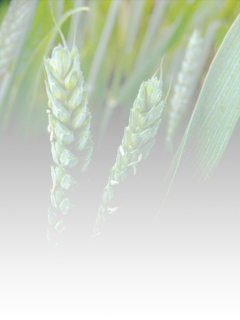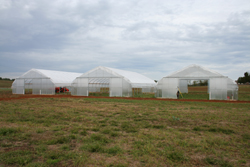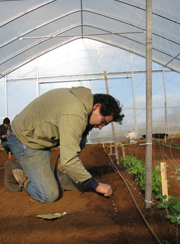Cool Season Specialty Crops in High Tunnels
(Rogers, Wszelaki and Smith) |
||
|
Introduction High tunnels are relatively low cost, unheated structures that can be used to extend the growing season in cool climates, or provide opportunities for year-round production. High tunnels are less expensive and easier to maintain than greenhouses, but offer a protected environment for production of high value fruits and vegetables. The objective of this experiment was to evaluate the performance of a variety of different cool season crops for winter production in East Tennessee, and to compare the season extending capabilities of high tunnels versus an inexpensive low tunnel system. Plant growth, yield and quality were measured, as well as incidence of pests and diseases. Methods and Materials Season Extension Structures- Construction of three high tunnels was finished in mid-October, 2008, and this project was started soon after. The high tunnels are 30 x 48’ with 14’ high gothic arches (Griffin Greenhouse, Knoxville, TN). There is a double layer of 6 mil, greenhouse grade, UV treated polyethylene plastic and 6’ roll-up sides. Polycarbonate sliding doors were installed on either end of the tunnels, allowing entry for a small tractor. Low tunnels were constructed using 10 gauge steel wire hoops, covered with Agribon Ag-50 frost blankets. This fabric is 1.5 oz per square yard, and protects plants to 24° F with 50% light transmission. The fabric was pulled over the hoops and anchored to the ground with landscape staples. Weather Station Data- HOBO soil temperature loggers (Onset Computer Corporation, Bourne, MA) were used to record soil temperatures every 10 min. Soil temperatures were averaged from seven probes used in the high tunnels and eight probes used in the low tunnels. Outside air temperatures were measured using a Davis Vantage Pro 2 weather station, model 6152 (Davis Instruments, Hayward, CA). Site Preparation- Prior to planting, the high and low tunnels were rototilled to a depth of 6” with a rotary tiller (Bush Hog, Selma, Alabama). Using a lawn spreader, soybean meal (7-2-1 NPK) was applied to both high and low tunnel areas at the rate of 4 lbs per 100 square feet (122 lbs N per acre). Irrigation was established with plastic drip tape, emitting water every 12” (Netafim, Tel Aviv, Israel). Tape was laid down in 9 rows with 2’ alleys in between each row. Plots for each crop were 7’ long by 2’ wide and replicated 3 times (each high tunnel and corresponding set of low tunnels was a replication). Crops and Varieties- Three different varieties of 11 crops, two varieties of Swiss chard and six varieties of lettuce were used in this study. All seed was untreated or certified organic. The crops and varieties were as follows: Broccoli (‘DeCicco’, ‘Waltham’, ‘Belstar’) Spinach (‘Butterflay’, ‘Bloomsdale’, ‘Matador’) Kale (‘Lacinato’, ‘Red Russian’, ‘True Siberian’) Lettuce (‘Kweik’, ‘Winter Density’, ‘Brune D’Hiver’, ‘Ruben’s Red Romaine’, ‘Drunken Woman Frizzy Headed’, ‘Red Oakleaf’) Leeks (‘Varna’, ‘Longfall’, ‘Blaugruner’) Radish (‘Round Black Spanish’, ‘Cherry Belle’, ‘Miyashige White Daikon’) Cauliflower (‘Grafiti’, ‘Odysseus’, ‘Cassius’) Kohlrabi (‘Dyna’, ‘Kolibri’, ‘Superschmelz’) Beets (‘Moneta’, ‘Golden Detroit’, ‘Chioggia’) Sweet peas (‘Mammoth Melting’, ‘Cascadia’, ‘Sugarsnap’) Carrots (‘Red Core Chantenay’, ‘St. Valery’, ‘Oxheart’) Onions (‘Mini Purplette’, ‘Evergreen’; ‘Parade’) Swiss chard ('Chadwick's Choice' and 'Glattersilber')
Conclusion This evaluation showed that crops grown inside the high tunnels were substantially larger in size and produced more harvestable material than those grown outside in the low tunnels from 28-Oct-08 to 13-Mar-09. Not all crops in the high tunnels were successful, however. Crops that did not do well, in terms of growth and maturity were: sweet peas (‘Mammoth Melting’, ‘Cascadia’, ‘Sugarsnap’); beets (‘Moneta’, ‘Golden Detroit’, ‘Chioggia’); carrots (‘Red Core Chantenay’, ‘St. Valery’, ‘Oxheart’); cauliflower (‘Grafiti’, ‘Odysseus’, ‘Cassius’); onions (‘Mini Purplette’, ‘Evergreen’; ‘Parade’). The optimum soil temperature for sweet peas is 55-65°F. Beets have an optimum soil temperature of 60-65°F. For carrots to germinate, soil temperatures of 75°F are required, but 60-70°F are good for carrot growth. Transplanted cauliflower grows best in 60-70°F soils, and transplanted onions grow best in 65-85°F. Poor germination in the high tunnels can be explained by the low soil temperatures, which were well below those required for germination and growth. Lettuces, which performed much better in the high tunnels, are adaptable to soil temperatures of 40-60°F. Winter temperatures on the University of TN Organic Crops Unit for 2008-2009 were not significantly different from 2007-2008. Starting the above cool season crops in high tunnels in early late August or early September would probably increase chances of a successful fall harvest, or starting crops in mid February for early spring harvest. In the middle of winter, high tunnel production in East Tennessee is best geared towards leafy crops, which can withstand cooler soil temperatures. The low tunnel system using 10 gauge steel wire hoops and Agribon Ag-50 frost may offer a few weeks of season extension in the fall and spring, but should not be used for winter production, as temperatures often dip below the 24°F of protection offered. This low tunnel system is also sensitive to wind, as heavy winds caused the fabric to tear where it attached to the landscape staples. Kale is frost hardy to 20°F, and was the only crop in good condition in the low tunnels at the end of the experiment.
|
|





